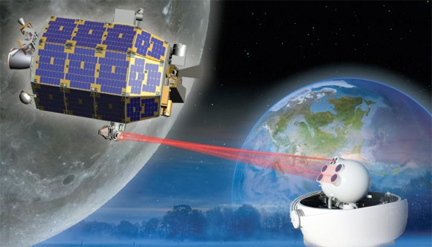The 100-day LADEE robotic mission, operated by NASA’s Ames Research Center in Moffett Field, Calif., is carrying four payloads to the moon. Three are for dust collection and analysis of the moon’s thin atmosphere. The fourth payload is the Lunar Laser Communication Demonstration (LLCD).

The LADEE satellite in lunar orbit. The revolutionary modular science probe is equipped with a Lunar Laser Communication Demonstration (LLCD) that will attempt to show two-way laser communication beyond Earth is possible, expanding the possibility of transmitting huge amounts of data. This new ability could one day allow for 3-D High Definition video transmissions in deep space to become routine.
Image Credit—NASA
“We like to say that Moog makes missions go,” said Eric Anderson, chief technologist for Moog’s Space Sector. “The LADEE mission showcases the diverse and comprehensive technology Moog offers the space industry.”
During the launch of LADEE on a Minotaur V rocket, a Moog SoftRide vibration isolation system reduced energy transmission between the launch vehicle and the satellite; attitude control system components made by Moog oriented the vehicle. To establish and maintain its lunar orbit, LADEE is relying on Moog-designed thrusters and latch valves, which are part of the spacecraft’s propulsion system. Moog’s integrated avionics unit (IAU) controls the spacecraft and interfaces to the four LADEE payloads. The Moog avionics unit includes a flight control computer and data handling.
Before the mission launched, engineers put in place Moog environmental control system technology to protect LADEE as a specially rigged truck transported the spacecraft from California to Virginia.


